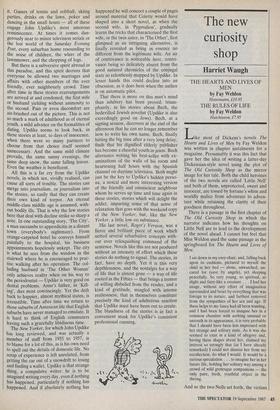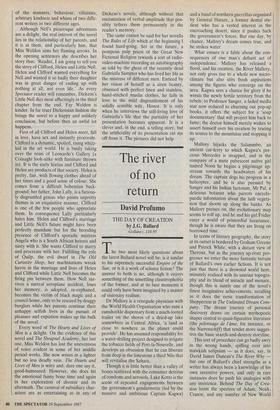The new curiosity shop
Harriet Waugh
THE HEARTS AND LIVES OF MEN by Fay Weldon
Heinemann, £10.95
THE RULES OF LIFE by Fay Weldon
Hutchinson, £7.95
Like most of Dickens's novels The Hearts and Lives of Men by Fay Weldon was written in chapter instalments for a magazine. Presumably it was this fact that gave her the idea of writing a latter-day Dickensian-style novel using the plot of The Old Curiosity Shop as the mirror image for her tale. Both the child heroines of the two novels are called 'Little Nell' and both of them, unprotected, sweet and innocent, are tossed by fortune's whim and worldly malice from adventure to adven- ture while retaining the clarity of their goodness throughout.
There is a passage in the first chapter of The Old Curiosity Shop in which the narrator indicates how his thoughts on Little Nell are to lead to the development of the novel ahead. I cannot but feel that Miss Weldon used the same passage as the springboard for The Hearts and Lives of Men:
I sat down in my easy-chair, and, falling back upon its cushions, pictured to myself the child in her bed — alone, unwatched, un- cared for (save by angels), yet sleeping peacefully. So very young, so spiritual, so slight and fairy-like a creature . . . I had her image, without any effort of imagination surrounded and beset by everything that was foreign to its nature, and farthest removed from the sympathies of her sex and age. If these helps to my fancy had all been wanting, and I had been forced to imagine her in a common chamber with nothing unusual or uncouth in its appearance, it is very probable that I should have been less impressed with her strange and solitary state. As it was she seemed to exist in a kind of allegory and, having these shapes about her, claimed my interest so strongly that (as I have already remarked) I could not dismiss her from my recollection, do what I would. It would be a curious speculation . . . to imagine her in her future life, holding her solitary way among a crowd of wild grotesque companions — the only pure, fresh, youthful object in the throng.
And so the two Neils set forth, the victims of the manners, behaviour, villainies, arbitrary kindness and whims of two diffe- rent writers in two different ages.
Although Nell's picaresque adventures are a delight, the real interest of the novel lies in the relationship of her parents, and it is at them, and particularly him, that Miss Weldon aims her flaming arrows. In the opening sentences she describes her story thus: 'Reader, I am going to tell you the story of Clifford, Helen and Little Nell. Helen and Clifford wanted everything for Nell and wanted it so badly their daughter was in great danger of ending up with nothing at all, not even life.' As every Spectator reader will remember, Dickens's Little Nell dies most affectingly in the third chapter from the end. Fay Weldon is kinder. In far truer Dickensian fashion she brings the novel to a happy and unlikely conclusion, but before then an awful lot happens.
First of all Clifford and Helen meet, fall in love, have sex and instantly procreate. Clifford is a dynamic, spoiled, rising whizz- kid in the art world. He is busily taking over the reins of Leonardo's Gallery (a Colnaghi look-alike with furniture thrown in). It is the early Sixties and Clifford and Helen are products of that society. Helen is pretty, fair, with flowing clothes ahead of her times and a good sense of colour. She comes from a difficult bohemian back- ground; her father, John Lally, is a furious- ly disgruntled genius who paints unpretty themes in an exquisitive manner. Clifford is one of the few people who appreciate them. In consequence Lally particularly hates him. Helen and Clifford's marriage and Little Nell's future might have been perfectly mundane but for the brooding presence of Clifford's sporadic mistress Angela who is a South African heiress and nasty with it. She wants Clifford to marry and procreate with her. Fulfilling the role of Qui1p, the evil dwarf in The Old Curiosity Shop, her machinations wreak havoc in the marriage and lives of Helen and Clifford while Little Nell becomes the firing pin between them. How Nell sur- vives a surreal aeroplane accident, loses her memory, is adopted, re-orphaned, becomes the victim of black magic and a council home, only to be rescued by druggy burglars while her parents continue their unhappy selfish lives in the pursuit of pleasure and expiation makes up the bulk of the novel.
Every word of The Hearts and Lives of Men is a delight. On the evidence of this novel and The Shrapnel Academy, her last one, Miss Weldon has lost the unevenness of voice evident in some of her middle period works. She now writes in a lighter but no less deadly vein. The Hearts and Lives of Men is witty and, dare one say it, good-humoured. However, she does hit the emotional funny bone time and again in her exploration of divorce and its aftermath. The carnival of subsidiary char- acters are as entertaining as in any of Dickens's novels, although without that encrustation of verbal amplitude that pos- sibly tethers them permanently in the reader's memory.
The same cannot be said for her novella The Rules of Life which at the beginning I found hard-going. Set in the future, a poMpous pulp priest of the Great New Fictional Religion rewinds a sort of radio- video-machine recording an autobiography as told by the ghost of the recently dead Gabriella Sumpter who has lived her life as the mistress of different men. Enticed by her vision of herself as a siren beauty, obsessed with perfect linen and stainless, hand-stitched muslin clothes, he falls in love to the mild disgruntlement of his solidly sensible wife, Honor. It is only when he interviews the still-living love of Gabriella's life that the partiality of her presentation becomes apparent. It is a clever and, in the end, a telling story, but the artificiality of its presentation cut we off from it. The pictures did not help.



































































 Previous page
Previous page